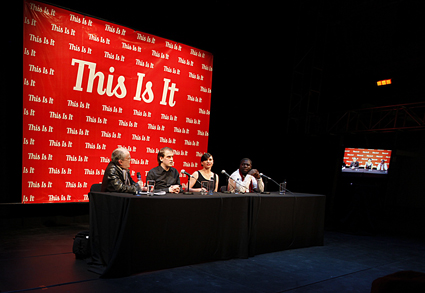everything but existence
julie robson: team mess, this is it

This Is It, Team MESS
photo Ponch Hawkes
This Is It, Team MESS
THE STAGE IS SIMPLY BUT STYLISHLY SET FOR A PRESS CONFERENCE. BEHIND THE LONG BLACK TABLE WITH DESK MICROPHONES AND GLASSES OF WATER IS A RED AND WHITE WALL POSTER WITH A BOTOX-INJECTED FONT REPEATING LOUDLY “THIS IS IT.”
Entering the PICA performance space, the audience have been given a press kit for a fictitious film of the same name as the show, but not much time to read it. When the lights go down we are shown five short cinematic trailers, each one laden with suspense, desire and danger: a woman’s fingernails plunge into eroticised back flesh; a man discovers a buried suitcase while walking in a grim Australian forest; and a cloaked, menacing figure is silhouetted by tongues of fire.
Shot in distinctive art house style but also with unashamed cliché, these suggestive glimpses prepare us for the press conference to follow, the format on which the rest of the performance is based.
The charismatic media presenter for the PICA performance season is special guest Mark Naglazas, a journalist from the West Australian newspaper, acting for all the world as if the audience are also members of the press who will soon be in possession of the roving microphone. Promoted thus to industry colleagues, we all applaud when Naglazas introduces the faux celebrities onto the stage. As they gesture regally to the paparazzi, we take in the elegant Natalie Kate Randall, who plays Caroline the smouldering vamp and victim; a slightly goofy Malcom Whittaker, the naive hero Jim, Caroline’s devoted lover; and Frank Mainoo, an Olympic silver-medalist boxer turned actor who is the villainous kidnapper in the film. Just as the five trailers were an excessive introduction the actors also deliberately take their time waving, smiling and loving their audience loving them. When Naglazas kicks off the questions we hear vague and seemingly articulate accounts of working with a risky, mad director (Dara Gill, also the director of the performance), coping with the demands of largely improvised shoots (writer credits actually go to Simi Knezivic) and dealing with the on and off-stage sexual tension between cast members. The performers have a strong and relaxed rapport, even if their stage presence is not always amped or magnetic.
The show intensifies when a complicit audience starts to fire the questions, introducing themselves as official representatives from real or fake radio stations, newspapers or magazines. It is an intimate crowd, and some are known local performers (not plants) who take on the mantle of the press club expert with relish and comic sensibility. This foray into multiple authorship and improvisation adds a frisson and live-ness to what has now become a choose-your-own-adventure story. Open to any twist or turn that questions and answers may take, the film’s narrative and its behind-the-scenes antics build in horror, humour and sordidness. On this particular evening, the implied gratuitous violence and sexual antics involving Caroline are especially disturbing, mirroring the same morbid fascination that television has for dead or compromised women. We cannot know if the same stories emerge in other performances or if this trajectory is as provisional as everything else in This Is It.
This is a cheeky show that delights in playing with art and artifice. Rather than competing with the film genre, it confidently exploits that genre’s codes and celebrity culture to make participatory theatre. Renewing itself and its possibilities with every run, audiences are invited to speculate, enter into dialogue with and, potentially, reflect on what puts the pop in our popular entertainment. In Baudrillard’s terms, this is a work that perpetuates “the simulation of something which never really existed,” giving the title its sharp irony.
For some, this performance will have interrogated the vacuousness of our increasingly marketing-driven and fame-obsessed existence, and our mythologising of artists. For others, it will have been as unmemorable as the gossip and scandal in yesterday’s trash magazine. Those who loved the fun, confusion and masquerading of it all may even have hung around after the show to collect signatures on the dedicated autograph page at the back of the film’s deluxe brochure. With its foundation of illusion and spectacle, This Is It can flicker in and out of all these readings and more.
This performance is the work of Team MESS, an energetic and interdisciplinary collective of emerging artists (mostly graduates from Wollongong University) who are worth keeping an eye on. Enabled by the development and presentation programs of PICA and Performance Space, they have spun a playful ruse entangling truth and fiction with art and identity.
This Is It, created and performed by Team MESS, Dara Gill, Sime Knezevic, Frank Mainoo, Natalie Randall, Malcolm Whittaker; PICA, Perth, July 13-16
See also Jana Perkovic’s review of Team MESS at Artshouse.
RealTime issue #105 Oct-Nov 2011 pg. 33






